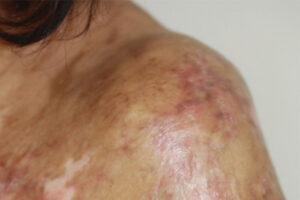Oncology
Chronic Graft-versus-Host Disease
Managing Oral Manifestations of Chronic Graft-versus-Host Disease: Opportunities for Multidisciplinary Care
Chronic graft-versus-host disease (cGVHD) can be associated with severe oral and mucosal symptoms that can negatively impact quality of life. Further, affected patients are at greater risk for developing squamous cell carcinoma of the mucosa. All of this highlights the importance of a collaborative, multidisciplinary care approach to monitoring and managing oral cGVHD.
Oral manifestations of cGVHD are common and varied, and they include tissue and mucosal sensitivity, salivary gland dysfunction, symptoms of sicca syndrome, altered taste (dysgeusia), and xerostomia. In more severe forms, patients cannot open their mouths, or they have difficulty swallowing because of cGVHD affecting the esophageal mucosa and the skin around the lip. It is also important to note that patients who have oral cGVHD have a higher risk of developing squamous cell carcinoma of the mucosa.
Topical therapies such as steroid and lidocaine viscous swishes are the cornerstone of oral cGVHD disease management. These are very effective for mild to moderate oral cGVHD, and they actually help in reducing tissue sensitivity and preventing infection. Moderate to severe manifestations such as severe xerostomia, severe lichenoid mucositis, or severe ulcerations may require systemic therapy. Systemic therapy should be combined with topical therapy as a way of being able to reduce or minimize the need for steroid use. There are currently no US Food and Drug Administration–approved topical therapies for oral cGVHD, but both steroids and calcineurin inhibitor oral rinses are regularly used. When lesions are widespread, rinses are recommended to facilitate application to all sites. Localized lesions may be treated with higher-potency steroid gels or ointments that can be applied under gauze occlusion to maximize the local effect. In general, however, when there are multiple lesions, you really need to use the rinses. Some centers are also exploring the use of low-level laser therapy, also known as photobiomodulation therapy, to help manage the pain and oral manifestations of cGVHD. There are some data suggesting that it may be effective, but it has not been approved for this indication.
The potential severity of oral cGVHD, along with the higher risk of squamous cell carcinoma, underscores the importance of using a multidisciplinary team approach and of the role of dental professionals in the early identification of lesions. It is essential to have a multidisciplinary team that includes a dentist, a dental hygienist, a primary care physician, and a transplant specialist involved to make sure that these patients have the best oral health possible and that their cGVHD is managed appropriately. Additionally, we request that patients be seen by their dentists at least once per year to identify the early development of lichenoid mucositis, salivary gland dysfunction, and/or other ulcerations that are manifestations of oral GVHD.
Ultimately, the best way to treat GVHD is to prevent it. The continued exploration of optimal GVHD prevention strategies is essential because patients who have undergone an allogeneic transplantation, in general, will always be at risk for developing cGVHD. The entire health care team needs to be adequately educated on the early manifestations and symptoms of this condition so that any symptoms can be appropriately evaluated at each patient visit.
Dean D, Sroussi H. Oral chronic graft-versus-host disease. Front Oral Health. 2022;3:903154. doi:10.3389/froh.2022.903154
Epstein JB, Raber-Durlacher JE, Epstein GL, Hazenberg MD, Tzachanis D, Spielberger RT. Chronic oral graft-versus-host disease: induction and maintenance therapy with photobiomodulation therapy. Support Care Cancer. 2021;29(3):1387-1394. doi:10.1007/s00520-020-05626-3
Haas L, Cruz-Pamplona M. Topical treatment of oral chronic graft-versus-host-disease in hematopoietic stem cell transplant recipients: a systematic review. J Clin Exp Dent. 2023;15(5):e420-e427. doi:10.4317/jced.60138
Johnson LB, Oh U, Rothen M, et al. A review of oral chronic graft-versus-host disease: considerations for dental hygiene practice. J Dent Hyg. 2022;96(2):6-17.
Kaurinovic M, Delli K, Jonk A-ME, et al. Effect of ruxolitinib on the oral mucosa of patients with steroid-refractory chronic graft-versus-host disease and oral involvement. Clin Oral Investig. 2022;26(5):4209-4216. doi:10.1007/s00784-022-04393-1
Laheij AMGA, Raber-Durlacher JE, Hazenberg MD, Schoordijk MCE, Huysmans MCDNJM, de Visscher JGAM. Oral chronic graft versus host disease, what is it and how is it treated? Article in Dutch. Ned Tijdschr Tandheelkd. 2022;129(7-8):329-336. doi:10.5177/ntvt.2022.07/08.22035
Tollemar V, Garming Legert K, Sugars RV. Perspectives on oral chronic graft-versus-host disease from immunobiology to morbid diagnoses. Front Immunol. 2023;14:1151493. doi:10.3389/fimmu.2023.1151493
Treister N, Duncan C, Cutler C, Lehmann L. How we treat oral chronic graft-versus-host disease. Blood. 2012;120(17):3407-3418. doi:10.1182/blood-2012-05-393389











